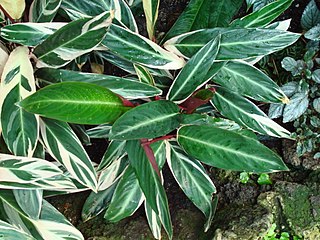
Psidium is a genus of trees and shrubs in the family Myrtaceae. It is native to warmer parts of the Western Hemisphere.
Romanoa tamnoides is a species of plant of the family Euphorbiaceae. It is the sole species in the monotypic genus Romanoa, first described in 1824. It is native to Brazil and Paraguay.

Campomanesia is a genus in the family Myrtaceae described as a genus in 1794. It is native to South America and Trinidad.

Plinia is a genus of flowering plants in the myrtle family, Myrtaceae described by Linnaeus in 1753. It is native to Central and South America as well as the West Indies.

Dimorphandra wilsonii is a tree species of legume of the family Fabaceae. It is found only in the Minas Gerais state of south-east Brazil, in regions close to the city of Belo Horizonte. Its natural habitat is moist savanna, called Cerrado, in areas of transition of Atlantic Forest. Due to habitat loss, it is critically threatened. Its population is fragmented and seriously reduced, with less than two dozen known individuals.
Syagrus macrocarpa is a rare species of palm found only as scattered isolated individuals and small groups in the east of the Brazilian states of Espírito Santo, Minas Gerais and Rio de Janeiro. It grows to 4-10m tall, with 8-20 leaves to 2m long. The leaves are bent at the end, with very hairy margins near the trunk, and consist of 180-320 slightly coiled leaflets irregularly arranged in several planes on the rake. The fruit are oval, greenish-yellow, 6–9 cm long. It is grown in cultivation. Seeds are difficult to germinate, with low rates of germination. Common names for it in Minas Gerais are baba-de-boi-grande and maria-rosa.

Blepharocalyx is a genus of plant in family Myrtaceae first described as a genus in 1854. It is native to South America and the West Indies.
- Blepharocalyx cruckshanksii(Hook. & Arn.) Nied. - Chile
- Blepharocalyx eggersii(Kiaerskou) L.R.Landrum - Lesser Antilles, Venezuela, Guyana, Peru, Brazil
- Blepharocalyx myriophyllus Mattos - Minas Gerais
- Blepharocalyx salicifolius(Kunth.) O.Berg - Brazil, Bolivia, Peru, Ecuador, Paraguay, Uruguay, N Argentina

Ctenanthe is a genus of flowering plants of the family Marantaceae described as a genus in 1884. They are evergreen perennials, native to Central and South America. They are grown for their attractive, often variegated foliage. They are frost tender, requiring a minimum temperature of 13 °C (55 °F).

Asterostigma is a genus of flowering plants in the family Araceae. It is native to Brazil and Argentina. The leaves are pinnate and the plant is tuberous.
- Asterostigma cryptostylumBogner - Brasília, Goiás, Minas Gerais
- Asterostigma cubense(A.Rich.) K.Krause ex Bogner - São Paulo
- Asterostigma lividum(G.Lodd.) Engl. - southern Brazil; Misiones Province of Argentina
- Asterostigma lombardiiE.G.Gonç. - Minas Gerais, Espírito Santo
- Asterostigma luschnathianumSchott - southern Brazil
- Asterostigma reticulatumE.G.Gonç - southern Brazil
- Asterostigma riedelianum(Schott) Kuntze - eastern Brazil
- Asterostigma tweedieanumSchott - Santa Catarina in southern Brazil

Constantia is a genus of flowering plants from the orchid family, Orchidaceae. It contains 6 known species, all endemic to Brazil:
- Constantia australis(Cogn.) Porto & Brade - Santa Catarina
- Constantia cipoensisPorto & Brade - Minas Gerais
- Constantia cristinaeF.E.L.Miranda - Minas Gerais
- Constantia gutfreundianaChiron & V.P.Castro - Minas Gerais
- Constantia microscopicaF.E.L.Miranda - Minas Gerais
- Constantia rupestrisBarb.Rodr. - Rio de Janeiro

Skeptrostachys is a genus of flowering plants from the orchid family, Orchidaceae. It is native to eastern South America.
Picrasma crenata, the pau-amargo, pau-tenente or tenente-josé, is a tree species that belongs to the family Simaroubaceae. It occurs in Brazil, in the regions Nordeste, Sudeste and Sul.
Maytenus aquifolia, the espinheira-santa, is an endemic tree species endemic to the Atlantic Forest biome in southeastern Brazil,
Agalinis itambensis is a plant species endemic to Brazil. It is known only from Serra do Itambé in the State of Minas Gerais.
Eriothymus is a genus of flowering plant in the family Lamiaceae, first described as a genus in 1835. It contains only one known species, Eriothymus rubiaceus. It is endemic to the State of Minas Gerais in Brazil.

Macroditassa is a genus of plant in family Apocynaceae, first described as a genus in 1927. It is native to South America.

Barbacenia is a plant genus in the family Velloziaceae, described as a genus in 1788. The entire genus is endemic to Brazil with the exception of B. celiae, which crosses the border into Venezuela.
Hemipogon is a genus of flowering plants in the family Apocynaceae, first described as a genus in 1844. It is native to South America.

Gaylussacia pulchra is a plant species in the family Ericaceae. It is native to the States of Bahia and Minas Gerais in eastern Brazil.

Symphyotrichum martii is a species of flowering plant in the family Asteraceae endemic to Minas Gerais, Brazil. It is a perennial, herbaceous, hairless plant whose flowers have about 30 white ray florets.












